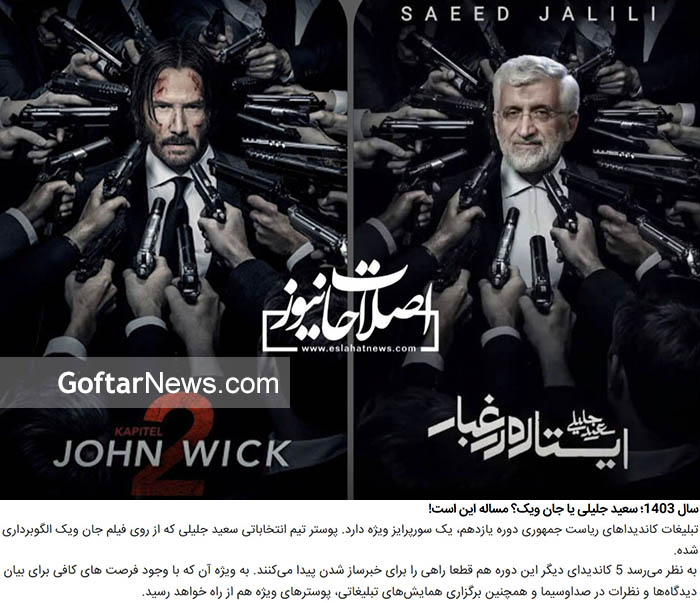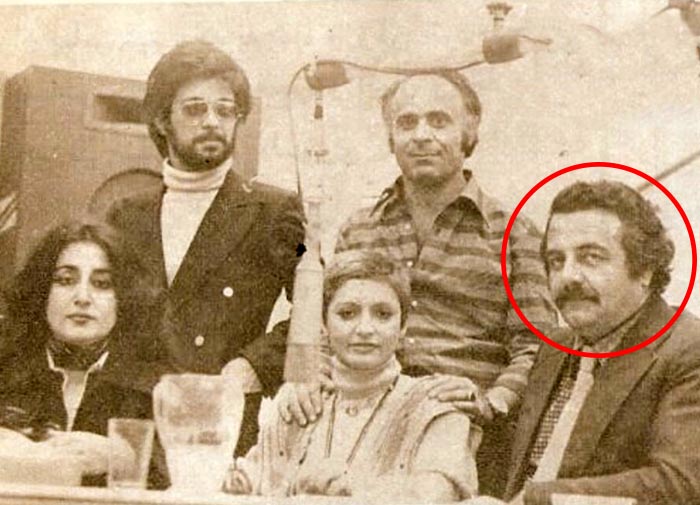6 Bold Hollywood-Inspired Posters of Saeed Jalili and Bagher Qalibaf Rival John Wick’s Iconic Imagery
Year 1403: Saeed Jalili or John Wick? The Dilemma
The 11th presidential election period introduces a unique surprise: Saeed Jalili’s campaign posters modeled after the action-packed style of John Wick. This bold move suggests that other candidates will also employ innovative strategies to captivate voters. With ample opportunities for media exposure, including radio and television, as well as promotional conferences, the election promises to be as dynamic as ever.
Hollywood-inspired posters of Saeed Jalili and Bagher Qalibaf, rivaling John Wick, highlight the evolving landscape of political advertising in Iran, aiming to engage and influence the electorate in ever more creative ways. This trend is part of a broader shift in political marketing, where candidates increasingly use visual storytelling to create compelling narratives that resonate with voters on an emotional level.
The Evolution of Political Campaign Posters in Iran
Political campaign posters have come a long way since the early days of the Iranian Republic. Initially, posters were simple and functional, often featuring little more than a photograph of the candidate and a brief slogan. Over time, however, the art of political poster design has evolved, becoming increasingly sophisticated and visually striking.
The Early Years: Functional and Direct
In the early years of the Iranian Republic, political posters were largely functional, designed to convey basic information about the candidate and their platform. These posters often featured a straightforward photograph of the candidate, accompanied by a brief slogan or statement of their key policies. The primary goal was to ensure that voters recognized the candidate and understood their main message. While these early posters were effective in their own way, they lacked the visual flair and emotional appeal of modern political advertising.
The Rise of Visual Storytelling
As political campaigns became more sophisticated, so too did their use of visual media. Candidates began to recognize the power of visual storytelling in shaping voter perceptions and influencing public opinion. This shift was driven in part by advances in printing technology, which made it possible to produce high-quality, full-color posters at a relatively low cost. It was also influenced by the increasing prevalence of visual media in everyday life, as television and later the internet became major sources of information and entertainment.
The Influence of Pop Culture
One of the most notable trends in the evolution of political posters is the increasing influence of pop culture. Candidates have increasingly drawn on popular movies, television shows, and other cultural phenomena to create posters that resonate with voters. This trend is exemplified by Saeed Jalili’s John Wick-inspired posters, which leverage the popularity and visual style of the Hollywood action movie to create a powerful and memorable campaign image.
The Role of Digital Media
The rise of digital media has also had a profound impact on the design and distribution of political posters. While traditional print posters remain an important tool for reaching voters, digital posters and social media graphics have become increasingly important. These digital materials can be shared widely and quickly, reaching a larger audience than print posters alone. They also allow for more dynamic and interactive forms of visual storytelling, incorporating elements such as animation, video, and hyperlinks.
The Psychology of Political Posters
The design of political posters is not just an art form; it is also a science. Effective posters draw on principles of psychology to capture attention, convey a message, and persuade voters. Understanding these principles can help to explain why certain posters are more effective than others and how candidates can use visual media to their advantage.
Attention and Perception
One of the primary goals of a political poster is to capture the viewer’s attention. This is particularly important in a crowded and competitive media environment, where voters are bombarded with information from multiple sources. To capture attention, posters often use bright colors, bold fonts, and striking images. These elements help to draw the viewer’s eye and make the poster stand out from its surroundings.
Emotion and Persuasion
Emotional appeal is another key element of effective political posters. Research has shown that emotions play a critical role in shaping voter behavior and decision-making. Posters that evoke strong emotions, such as hope, fear, or anger, are more likely to be remembered and to influence voters’ attitudes and behaviors. This is why many political posters use powerful imagery and emotive language to convey their message.
Simplicity and Clarity
While it is important for political posters to be visually striking, it is equally important for them to be clear and easy to understand. A poster that is too cluttered or complex can be confusing and may fail to convey its message effectively. The best political posters are simple and focused, using a few key elements to convey a clear and compelling message. This often involves the use of visual metaphors, such as Hassan Rouhani’s key, which encapsulate the candidate’s message in a single, memorable image.
The Future of Political Posters in Iran
The evolution of political posters in Iran reflects broader changes in the political and media landscape. As candidates continue to seek new ways to engage and persuade voters, we can expect to see further innovation in the design and use of political posters. This may include greater use of digital and interactive media, as well as continued experimentation with pop culture and visual storytelling.
The Impact of Social Media
Social media has transformed the way political campaigns are conducted, and this is particularly evident in the use of visual media. Platforms like Instagram, Twitter, and Facebook allow candidates to share their posters and other visual content with a wide audience quickly and easily. Social media also enables more interactive and engaging forms of visual communication, such as video clips, live streams, and interactive infographics.
The Use of Data Analytics
Data analytics is another area where political campaigns are likely to innovate in the future. By analyzing data on voter behavior and preferences, campaigns can create more targeted and effective visual content. This might involve using data to determine the most effective colors, fonts, and images to use in posters, or to identify the most important issues to highlight in visual media.
The Role of Augmented Reality and Virtual Reality
Augmented reality (AR) and virtual reality (VR) technologies offer exciting new possibilities for political campaigns. AR and VR can be used to create immersive and interactive experiences that engage voters in new ways. For example, a campaign might use AR to create interactive posters that come to life when viewed through a smartphone, or use VR to create virtual campaign events that voters can attend from the comfort of their own homes.
Conclusion
The bold Hollywood-inspired posters of Saeed Jalili and Bagher Qalibaf, reminiscent of John Wick’s iconic imagery, represent a new frontier in Iranian political advertising. These striking visuals are part of a broader trend towards more sophisticated and emotionally resonant political marketing. As candidates continue to innovate and experiment with new forms of visual media, we can expect to see even more creative and impactful campaign posters in the future. Whether through the use of pop culture references, digital media, or cutting-edge technologies like AR and VR, the future of political posters in Iran promises to be dynamic, engaging, and ever more attuned to the needs and preferences of voters.





